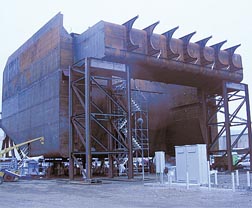forum
library
tutorial
contact

Vancouver-Built Weir may Help Fish
by Erik Robinson, Staff WriterThe Columbian, November 17, 2004
|
the film forum library tutorial contact |

|
Vancouver-Built Weir may Help Fishby Erik Robinson, Staff WriterThe Columbian, November 17, 2004 |
 A massive hunk of steel perched along the Columbia River shoreline in Vancouver embodies the latest hope for balancing electricity production and salmon protection.
A massive hunk of steel perched along the Columbia River shoreline in Vancouver embodies the latest hope for balancing electricity production and salmon protection.
The removable spillway weir will cost $12.8 million to build and install.
A bevy of federal officials who gathered at the base of the 1.7 million-pound contraption on a chilly and gray Tuesday morning extolled the investment.
When the Army Corps of Engineers installs the weir at Ice Harbor Dam near the Tri-Cities next spring, federal officials say they expect it will allow them to improve salmon survival while boosting the generation of hydroelectricity.
It also furthers the Bush administration's commitment that federal dams are here to stay.
"This is a tremendous, tremendous accomplishment," shouted Lt. Col. Randy Glaeser, the new commander of the corps' Walla Walla District.
Thompson Metal Fab Inc. is building the weir at its fabrication plant on the old site of the Kaiser Shipyard in Vancouver. John Rudi, Thompson's president, said the company added about 50 employees to its work force of 150 to complete the $9 million contract.
"This is great work for us," he said.
Three years ago, Thompson built a similar weir, the first of its kind, which the corps barged upriver and installed at Lower Granite Dam on the lower Snake River. If the Bush administration fulfills its commitment to install removable spillway weirs at five other federal dams before the decade is out, Thompson may get more business.
The weirs work like gigantic water slides, specially crafted for juvenile fish.
Generally, ocean-bound juvenile salmon smolts can pass a dam either by shooting down past the turbines or by sliding across spillways that were designed to release floodwater.
Biologists generally consider spilling water to be safer for imperiled salmon than sending them through turbines, where they might clang off the huge blades or suffer an effect similar to the bends in deep-sea divers. But spillway passage isn't a smooth ride, either. Juvenile fish must dive about 50 feet to reach the top of the spillway at Ice Harbor -- a difficult journey that creates some of the same gas-bubble effects as a trip through the turbines.
Neither method is ideal, and that's where the removable spillway weir comes in.
At Ice Harbor, also on the Snake, the weir will be attached to the crest of one of 10 spillways lined across the dam. The weir acts like a giant fliptop, rising from the spillway crest at the back of the dam to guide fish near the surface. Once the fish enter the slide, they're supposed to scoot smoothly and gradually through the dam and on to the ocean.
Salmon survival has increased from 93 percent to 98 percent with the weir in place at Lower Granite Dam, said Bob Lohn, regional administrator of the National Marine Fisheries Service. Although it will vary from dam to dam, Lohn said the weir at Ice Harbor will require the corps to divert only about one-seventh the amount of water it spills now to boost ocean-bound smolts past the dam.
The rest will be used to generate surplus electricity, which the Bonneville Power Administration can sell to utilities in California, theoretically lowering rates paid by Bonneville's Northwest customers.
"If you can save $10 million per year, that's a lot of money even for us," Bonneville Administrator Steve Wright said. "What you're always doing is looking for efficiencies across your program."
Those efficiencies are coming on the backs of imperiled salmon, one conservationist said.
Andrew Englander, a policy analyst with the Save Our Wild Salmon coalition, said the weir amounts to a technological fix that masks deeper problems created by dams that have transformed the wild Columbia River into a stair-stepping series of reservoirs. He pointed to a decision earlier this summer in which the Bush administration, for the first time, asserted that the operation of dams does not jeopardize salmon protected by the Endangered Species Act. In doing so, the government ruled out the idea of breaching Lower Granite, Ice Harbor, Little Goose and Lower Monumental dams on the lower Snake River.
"This could be construed as gold-plating the dams," Englander said, glancing toward the weir.
Lohn said the administration recognizes the dams have harmed salmon, creating large reservoirs where predators lurk, water temperatures rise and slow currents stymie migration.
But Lohn said his agency is legally obligated only to address how federal dams are operated not whether they exist in the first place.
"That doesn't mean the existence of the dams is benign or overlooked," he said.
Lohn said the dams' presence is a large part of the reason federal agencies are spending more than $300 million per year on salmon recovery in the Columbia River basin.
(bluefish notes: Elsewhere Lohn's agency projects $600 million per year on salmon recovery expenditures. NOAA press release).
learn more on topics covered in the film
see the video
read the script
learn the songs
discussion forum
